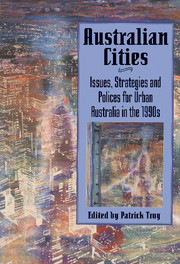Book contents
- Frontmatter
- Contents
- List of Figures
- List of Tables
- Preface
- Acknowledgements
- Note on Contributors
- Abbreviations
- Introduction
- Part I The Development and State of Australian Cities
- Part II Current Policies and Options
- 5 The Battle for Balmain
- 6 State Planning Operation
- 7 Planning in a Multicultural Environment: A Challenge for the Nineties
- 8 Local Government and the Urban Growth Debate
- 9 Towards More Equitable Cities: A Receding Prospect?
- Part III Avenues for Development
- References
- Index
6 - State Planning Operation
Published online by Cambridge University Press: 03 May 2011
- Frontmatter
- Contents
- List of Figures
- List of Tables
- Preface
- Acknowledgements
- Note on Contributors
- Abbreviations
- Introduction
- Part I The Development and State of Australian Cities
- Part II Current Policies and Options
- 5 The Battle for Balmain
- 6 State Planning Operation
- 7 Planning in a Multicultural Environment: A Challenge for the Nineties
- 8 Local Government and the Urban Growth Debate
- 9 Towards More Equitable Cities: A Receding Prospect?
- Part III Avenues for Development
- References
- Index
Summary
This chapter concentrates on recent planning initiatives in South Australia. It goes beyond official publications to review, comment on and provide a critique on those developments. In doing so it seeks to place them within a wider, if more superficial, appreciation of current trends in State urban planning operations generally. A major linkage is made between these two dimensions by analysing the concept of strategic planning which is a common ambition of all State operations, and a prominent and distinctive feature of the South Australian current experiments.
Setting the Scene
There are some background assumptions and interpretations that should be outlined. While government policies and actions of all kinds and all levels impact on urban conditions, the States build and operate the cities. Commonwealth policies and actions, whether targeted on urban issues or unintended in their urban impacts, have great influence. They tend to be more abstract in their character and effect. State policies involve constructing the built environment of the cities, operating it and servicing its people, so that they are a mixture of the abstract and the physical. Local policies are mainly physical in their orientation and impact and considerably influence the character of the street and the suburb.
- Type
- Chapter
- Information
- Australian CitiesIssues, Strategies and Policies for Urban Australia in the 1990s, pp. 142 - 163Publisher: Cambridge University PressPrint publication year: 1995
- 2
- Cited by



